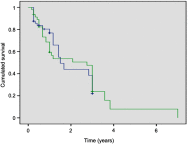Impact of tumor cytoreduction in metastatic prostate cancer
- PMID: 31192170
- PMCID: PMC6511624
- DOI: 10.2147/RRU.S204507
Impact of tumor cytoreduction in metastatic prostate cancer
Abstract
Objective: To assess the impact of tumor cytoreduction on cancer outcomes and patient survival in metastatic prostate cancer. Patients and methods: It is a prospective study spanning a two-year period between October 1st 2015 and March 31st 2017. We enrolled 102 cases of metastatic hormone-sensitive prostate cancer. Fifty-seven (57) patients had exclusively androgen deprivation therapy (ADT) (group 1) and 45 had, in addition, an open prostatectomy or Transurethral resection of the Prostate (group 2). We compared both groups using the total PSA nadir, the time to PSA nadir, the overall survival (OS), and the progression-free survival (PFS). Results: The average nadir PSA was lower for the tumor cytoreduction group (16.8±1.6 ng/mL (0.01-193.5) versus 110.7±17.9 ng/mL (0.01-1379)). Median time to PSA nadir was shorter in patients in the ADT only group (8 months vs 3 months (p=0.025)). The OS was shorter in patients treated with ADT only compared to the tumor cytoreduction group (median 14 months vs 24 months, respectively (p=0.03)). Similarly, tumor cytoreduction had a positive impact on patient progression (median PFS 20 months (group 1) vs 43 months (group 2)). Conclusion: Tumor cytoreduction has a positive impact on the oncological results and the survival of patients under ADT.
Keywords: TURP; androgen suppression; cytoreduction; prostate cancer.
Conflict of interest statement
The authors report no conflicts of interest in this work.
Figures



Similar articles
-
Survival outcomes of Chinese metastatic prostate cancer patients following primary androgen deprivation therapy in relation to prostate-specific antigen nadir level.Asia Pac J Clin Oncol. 2017 Apr;13(2):e65-e71. doi: 10.1111/ajco.12313. Epub 2014 Dec 3. Asia Pac J Clin Oncol. 2017. PMID: 25471685
-
Correlation of Prostate-specific Antigen Kinetics with Overall Survival and Radiological Progression-free Survival in Metastatic Castration-sensitive Prostate Cancer Treated with Abiraterone Acetate plus Prednisone or Placebos Added to Androgen Deprivation Therapy: Post Hoc Analysis of Phase 3 LATITUDE Study.Eur Urol. 2020 Apr;77(4):494-500. doi: 10.1016/j.eururo.2019.11.021. Epub 2019 Dec 13. Eur Urol. 2020. PMID: 31843335 Clinical Trial.
-
Prognostic significance of nadir PSA value and time to nadir PSA in patients with metastatic castration-naive prostate cancer receiving first-line hormonotherapy.J Cancer Res Ther. 2023 Jan 1;19(Suppl 2):S845-S850. doi: 10.4103/jcrt.JCRT_1527_20. Epub 2023 Dec 15. J Cancer Res Ther. 2023. PMID: 38102905
-
Abiraterone acetate in combination with androgen deprivation therapy compared to androgen deprivation therapy only for metastatic hormone-sensitive prostate cancer.Cochrane Database Syst Rev. 2020 Dec 12;12(12):CD013245. doi: 10.1002/14651858.CD013245.pub2. Cochrane Database Syst Rev. 2020. PMID: 33314020 Free PMC article.
-
The Importance of Time to Prostate-Specific Antigen (PSA) Nadir after Primary Androgen Deprivation Therapy in Hormone-Naïve Prostate Cancer Patients.J Clin Med. 2018 Dec 18;7(12):565. doi: 10.3390/jcm7120565. J Clin Med. 2018. PMID: 30567361 Free PMC article. Review.
Cited by
-
Cytoreductive radical prostatectomy or radiation therapy for metastases prostate cancer: Evidence from meta-analysis.Medicine (Baltimore). 2022 Sep 23;101(38):e30671. doi: 10.1097/MD.0000000000030671. Medicine (Baltimore). 2022. PMID: 36197186 Free PMC article.
-
Current Controversy and Developments Regarding the Cytoreductive Prostatectomy for Oligometastatic Prostate Cancer.Technol Cancer Res Treat. 2023 Jan-Dec;22:15330338231216011. doi: 10.1177/15330338231216011. Technol Cancer Res Treat. 2023. PMID: 38105493 Free PMC article. Review.
-
Tumor removal limits prostate cancer cell dissemination in bone and osteoblasts induce cancer cell dormancy through focal adhesion kinase.J Exp Clin Cancer Res. 2023 Oct 11;42(1):264. doi: 10.1186/s13046-023-02849-0. J Exp Clin Cancer Res. 2023. PMID: 37821954 Free PMC article.
-
Management of Advanced and Metastatic Prostate Cancer: A Need for a Sub-Saharan Guideline.J Oncol. 2019 Dec 5;2019:1785428. doi: 10.1155/2019/1785428. eCollection 2019. J Oncol. 2019. PMID: 31885569 Free PMC article. Review.
References
-
- Fall B, Tengue K, Sow Y, et al. Place of bilateral pulpectomy as a method of androgen suppression therapy in prostate cancer. Prog Urol. 2012;17(6):1027–3. - PubMed
-
- Qin X-J, Ma C-G, Ye D-W, et al. Tumor cytoreduction results in better response to androgen ablation: a preliminary report of palliative transurethral resection of the prostate in metastatic hormone sensitive prostate cancer. Urol Oncol. 2012;30:145–149. doi:10.1016/j.urolonc.2010.02.010 - DOI - PubMed
-
- Huggins C, Hodges CV. Studies on prostatic cancer. I. The effect of castration, of estrogen and of androgen injection on serum phosphatases in metastatic carcinoma of the prostate. Cancer Res. 1941;1:293–297. - PubMed
LinkOut - more resources
Full Text Sources
Research Materials
Miscellaneous

